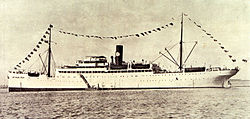Polynesia (ship)
|
Former Polynesia as Tel Aviv , 1935
|
||||||||||||||||||||||
|
||||||||||||||||||||||
|
||||||||||||||||||||||
|
||||||||||||||||||||||
|
||||||||||||||||||||||
The second Polynesia of the Hamburg-American Packetfahrt-Actien-Gesellschaft (Hapag) was a combined ship for the Kosmos service to the west coast of South America, where there was a joint venture with DDG Kosmos and Hapag was to increase its stake from 1905.
At the beginning of the First World War , the Polynesia started at Montevideo and was confiscated there when Uruguay entered the war and then brought into service as a Colonia .
In 1927 the shipowner Arnold Bernstein acquired the ship in Hamburg and operated it as Hohenstein . In 1935 he transferred the ship to the Palestine Shipping Company and used it as an emigrant ship Tel Aviv between Trieste and Haifa until 1938 .
history
The ship was one of the three sister ships of Polynesia class , which was built by the Hamburg shipping company for the service to the West Coast of America. These ships were replicas of the five Osiris ships that Blohm & Voss had delivered to DDG Kosmos for the same route between 1902 and 1904. The Hapag ships, however, had improved and enlarged passenger facilities.
The Polynesia (6,022 GRT) built by the Reiherstieg shipyard in Hamburg had cabins with two beds for up to 66 passengers in first class, for which a dining room with 49 seats was also available. The 24 passengers in the second class were accommodated in two or four-bed cabins. For up to 42 passengers on III. Four chambers were available in the stern of the 1st class.
On December 24, 1904, the Polynesia left for her maiden voyage and remained on the route to the American west coast until 1914, like her sister ships Thuringia (6,152 GRT, used as California until 1906 ) from Blohm & Voss and Thessalia (6,146 GRT) from Flensburg .
On August 5, 1914, was Polynesia due to the outbreak of the First World War in Montevideo launched . On September 4, 1917, the ship with the sister ship Thuringia, which was also lying up in Montevideo, was confiscated by the government of Uruguay and started sailing as Colonia .
In the service of Arnold Bernstein
In 1927 the shipowner Arnold Bernstein acquired the former Polynesia and operated it as Hohenstein . In 1935, Bernstein founded the Palestine Shipping Company in Haifa, which received the outdated Hohenstein under the name Tel Aviv . It was intended to provide a safe and inexpensive route for Jews to Palestine between Trieste and Haifa . The basis for safe relocation was the Ha'avara Agreement between the Zionists and the Reich Ministry of Economics , which, according to the will of the SS, enabled rapid departure and economic benefits for the German Reich and which took into account the initially existing British rules for settling in the Mandate area.
At the beginning of 1935 this ship made its first voyage from Bremerhaven to Haifa . During this voyage, the ship had the new name Tel Aviv on the hull in Hebrew letters , while the swastika flag waved from the mast , "a combination of metaphysical absurdity," a fellow traveler wrote later. The captain of the ship, Leidig, was a registered member of the NSDAP . The ship, registered in Haifa on May 17, 1935, remained in the Mediterranean and transported Jewish emigrants from Trieste to Haifa. The arrest of Bernstein in January 1937 and the subsequent obstruction of legal entry into Palestine withdrew the operating conditions of the Palestine Shipping Company.
In 1938 the ship was sold to Japan for demolition .
literature
- Arnold Kludas: The History of German Passenger Shipping. Volume III: Rapid growth 1900 to 1914 , writings of the German Maritime Museum, Volume 20
- Arnold Kludas: The History of German Passenger Shipping. Volume IV: Destruction and Rebirth 1914 to 1930 , Writings of the Deutsches Schiffahrtsmuseum, Volume 21
- Arnold Kludas: The History of German Passenger Shipping. Volume V: An era comes to an end 1930 to 1990 , Writings of the German Maritime Museum, Volume 22
- Klaus Polkehn : Zionism in a plot with National Socialism. Klartexte 9, Freiburg 1987
- Reinhardt Schmelzkopf: German merchant shipping 1919–1939. Verlag Gerhard Stalling, Oldenburg, ISBN 3-7979-1847-X .
Web links
- The Polynesia at Schiff-Maxim
- Report at nexusboard.net ( Memento from October 8, 2012 in the Internet Archive )
- Tel Aviv information on the Haifa Museum website
- Picture as Tel Aviv
